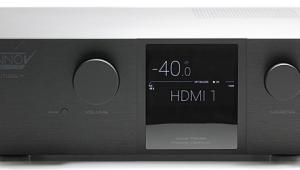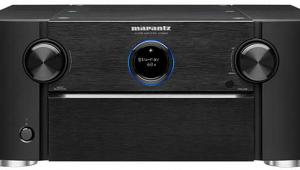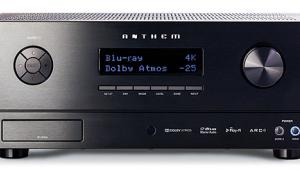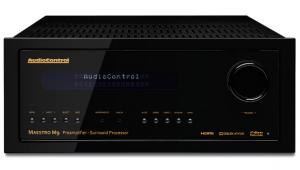Review: Emotiva UMC-200 preamp/processor and UPA-700 7-channel amp

Emotiva. The name sounds like the latest cure-all marketed by Big Pharma on the evening news programs. (Remember “restless leg?”) It is, in fact the consumer-audio brand of Tennessee’s Jade Designs. And Jade Designs, in turn, is the direct-to-consumer brand founded by a longtime veteran of the rough-and-tumble electronics OEM (original equipment manufacturing) world.
Though not the first to plow a consumer-direct, serious-audio furrow, Emotiva bills itself as “the first major audio brand of the 21st century” (its impressive success over the past 7 years doesn’t say otherwise), with a mission of making high-end affordable. The firm has quickly grown to the point where it offers no fewer than 19 electronics products (mostly amps, preamps, and processors), plus numerous loudspeakers, cables, and accessories, all (or nearly all) manufactured in China like the overwhelming majority of today’s consumer electronics.
For my initial dosage of Emotivas, I tested the firm’s new UMC-200 slim-line preamp/surround processor, and its UPA-200 7 x 80-watts power amp. Both are comparatively solid, well-finished components constructed along conventionally mass-production lines but with nice, thickly machined front panels dressed up a bit by brushed-aluminum corner plates. (I thought both units looked better with these nonfunctional escutcheons removed, but that’s just me. For like-minded others, black-anodized corners are an optional extra, as are rack-mount adapters that replace them.)
Setup
Emotiva makes setting up the UMC-200 unusually easy by omitting any video connections other than HDMI. Plug in a couple, run your 5, 6, or 7 analog cables linking the pre/pro and the power amp, and you’re done. Of course, there are plenty of other audio inputs and outputs, including 2 remote-zone stereo pairs, as well as a 7.1-channel input for an SACD player or other source. (The Emotiva does not decode DSD.) Somewhat unusually, the UMC-200 incorporates both a conventionally unbalanced RCA-jack subwoofer out and a balanced XLR one. I understand wanting to reject hum — something a balanced-line connection is particularly good at — on a long subwoofer run. Then again, I can’t remember ever having a subwoofer hum problem I couldn’t cure through proper grounding or cable dressing. Of course, Emotiva’s own X-Ref 12 subwoofer provides the matching balanced-XLR input.
The UMC-200 incorporates Gen2 of Emotiva’s own auto-setup/room-equalization routine, the whimsically named Emo-Q. This ran a series of pink-noise bursts (not sweep or pulse tones like some systems) in a slow but thorough rotation through the channels. The resultant channel levels were good when checked with my handheld sound-pressure meter (except center, which was several decibels low), though Emo-Q reported all of my speakers as “phase reverse” (they are not) and delivered a 130-Hz crossover for all five channels, which is demonstrably nearly an octave higher than necessary in at least three cases. But such vagaries are not uncommon among auto-cal ‘bots, and they were easily remedied via the manual setup menus.
I was a little less sanguine about Emo-Q’s room/speaker equalization. The curves it delivered were a bit different from the average of countless Audyssey and other-brand runs on the same room and speakers (which mostly converge fairly closely): a bit less cut in my room’s standing-wave-buildup region around 50 Hz, and a slight, somewhat unexpected boost in the next-to-top octave.
Since I always defeat auto-EQ for all of my listening tests (to keep the playing field level), this did not trouble me much, but what delighted me was discovering the UMC-200’s manual equalization capabilities. You get 11 bands of user-definable parametric EQ for each channel: 11 choices of center frequency, boost or cut (up to 3 or 10 dB, respectively), and “Q” (bandwidth and “sharpness”) times however many channels you have implemented in your system. There are three manual memories, so you can set up different equalizations for different sources, genres, or whatever.
Most audio-DSP chip sets incorporate such abilities (Emotiva uses dual Cirrus Logic 32-bit processors, which is a lot of horsepower), but few consumer manufacturers fully implement so potentially dangerous a feature. It’s simply too easy for the user to dial in Truly Bad Sound — which then gets blamed on the maker. But if you have the patience, the ear, and the self-restraint to use it to effect, it’s a very powerful one. Another similarly unusual feature: Crossover slopes can be individually set to 12 or 24 dB/octave by channel/pair. Most of us will want the standard 12-dB high-pass/24-dB low-pass defaults, but I appreciated the ability to fool around with these. (See my Extended Lab Notes on page 3 for more info on this topic.)
The UMC-200 decodes Dolby TrueHD and DTS-HD Master Audio formats, of course, but is otherwise blissfully free of extraneous surround modes. You’ll find no “Stadium” or “Disco” settings here, thank heavens. It also features Dolby PLIIz (I’m a fan), but the manual is strangely silent on how to configure it.
Emotiva throws in a USB port, too, but with no streaming audio onboard, it’s only used for Emotiva’s optional Bluetooth aptX module, which adds the wireless phone/pod/portable playability that apparently every component of every stripe must include to reach market today. The UMC-200’s lit implies that this is included, but no dongle accompanied our sample, so I could not, of course, try this.
- Log in or register to post comments





























































